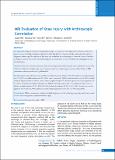Please use this identifier to cite or link to this item:
https://hdl.handle.net/20.500.14356/1794| Title: | MRI Evaluation of Knee Injury with Arthroscopic Correlation |
| Authors: | Gupta, M K Rauniyar, R K Karn, N K Sah, P L Dhungel, K Ahmad, K |
| Citation: | GuptaM. K., RauniyarR. K., KarnN. K., SahP. L., DhungelK., & AhmadK. (2014). MRI Evaluation of Knee Injury with Arthroscopic Correlation. Journal of Nepal Health Research Council. https://doi.org/10.33314/jnhrc.v0i0.441 |
| Issue Date: | 2014 |
| Publisher: | Nepal Health Research Council |
| Article Type: | Original Article |
| Keywords: | Arthroscopy Knee injury MRI |
| Series/Report no.: | Jan-April, 2014;441 |
| Abstract: | Abstract Background: Magnetic Resonance Imaging has emerged as the primary investigation for evaluation of the knee injury because of its high resolution and accuracy and it has often been regarded as the noninvasive alternative to diagnostic arthroscopy. The objective of this study was to find out the various types of traumatic lesions of the knee on MRI, to correlate the results with arthroscopy, and to establish the accuracy of MRI in detecting ligament and meniscal injury. Â Methods: This cross sectional study was conducted on 40 patients with knee injury over a period of one year. MRI of the knee followed by arthroscopy was performed in each case. Arthroscopy was done within 30 days of MRI examination and was considered as gold standard. Â Results: Various types of lesion seen on MRI were as follows: joint effusion 27 (67.5%), anterior cruciate ligament tear 23 (57.5%), medial meniscus tear 20 (50%), bone contusion 18 (45%), lateral meniscus tear 16 (40%), medial collateral ligament injury 16 (40%), lateral collateral ligament injury 14 (35%) and posterior cruciate ligament tear 14 (35%). Sensitivity, specificity and accuracy of MRI in detecting meniscal and cruciate ligament injury were as follows: medial meniscus: 85.7%, 89.4%, 87.5%; for lateral meniscus: 83.3%, 95.4%, 90%; for anterior cruciate ligament: 91.3%, 88.2%, 90%; and for posterior cruciate ligament: 92.8%, 96.1%, 95% respectively. Â Conclusions: MRI is a noninvasive, useful and reliable diagnostic tool for evaluating knee injury and it can be used as a first line investigation in patients with knee injury. Â Keywords: arthroscopy; knee injury; MRI. |
| Description: | Original Article |
| URI: | http://103.69.126.140:8080/handle/20.500.14356/1794 |
| ISSN: | Print ISSN: 1727-5482; Online ISSN: 1999-6217 |
| Appears in Collections: | Vol. 12 No. 1 Issue 26 Jan - Apr, 2014 |
Files in This Item:
| File | Description | Size | Format | |
|---|---|---|---|---|
| 441-Article Text-586-1-10-20140709.pdf | Fulltext Download | 568.22 kB | Adobe PDF |  View/Open |
Items in DSpace are protected by copyright, with all rights reserved, unless otherwise indicated.
